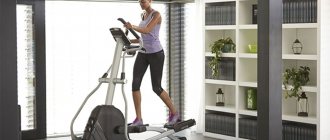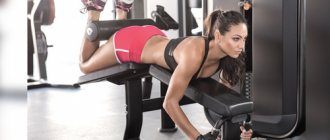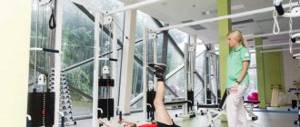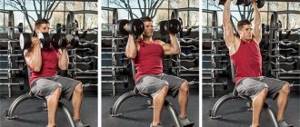Free weights[edit | edit code]
Under free weights
In bodybuilding and fitness we understand barbells, kettlebells and dumbbells. Some individuals also train with weights. Strength sports also use weighted ropes, sleds, sandbags, weighted balls, kegs, lifting stones, and fat barbells. In health fitness, there are various weighted vests and ankle and wrist weights.
Anything that is not fixed and whose trajectory is determined by the biomechanics of the body, and not by the “mobility” of the simulator, is free weight
. The point of working with free weights is to develop athletic qualities, not only pure strength, but also balance, joint mobility, as well as specific skills - “assembling” the center of the body under load, maintaining a neutral back.
Benefits of working with free weights[edit | edit code]
A significant advantage of working with free weights is versatility
. With dumbbells and a barbell, you can not only work out all the muscles of the body, but also train for endurance and increase the efficiency of the cardiovascular system. Such equipment can give us mass, strength, “relief”, and help in “burning” calories. A minimum set of weights is enough to build a home gym, and perform more than 30 different exercises for all muscle groups.
Proper technique for working with free weights is the key to preventing household injuries. It allows you to eliminate various “distortions” during lifting weights from the floor, gain the skill of squatting with a neutral back, improve the range of motion in the shoulder joints, and thereby avoid injury when lifting weights upward.
Working with free weights actively engages almost all the muscles of the body. With such weights we do basic exercises. They involve not only target groups, but also stabilizer muscles. The result is not only harmonious development, but a greater training effect. With simple equipment, we expend more energy during training and load more muscle groups per unit of time.
Training with free weights
- an important skill that allows you to train in almost any gym, while traveling, on trips, and even at home. This helps to avoid being tied to a specific gym and make training more regular.
Free weights
As mentioned above, the main benefit of barbell and dumbbell exercises is more efficient muscle growth and overall weight gain. The second significant advantage is the possibility of achieving a significant increase in the athlete’s strength indicators, which cannot be achieved on exercise machines. The widespread availability of free weights, as well as their relatively low cost, is another plus.
But what about the cons? The main disadvantage is the technical complexity of the exercises and their high risk of injury, especially for beginners. Incorrect exercise technique, coupled with the desire to lift as much weight as possible, is fraught with all sorts of injuries that can put an end to further training for those who are just starting their journey in the world of bodybuilding. From this emerges the need for safety net, which even experienced athletes need, and which is not always possible to obtain.
Features of training with free weights[edit | edit code]
main feature
- the need for complete mental concentration and knowledge of the basics of movement. During the lesson, distractions and extraneous thoughts are not allowed; the athlete must consciously monitor the trajectory of the projectile. This is quite difficult considering the fatigue and sensations in the muscles. That’s why free weights are not always used in health fitness right away.
Movement training required. The technique of working with free weights must be established; most people do not “grasp” it themselves from the first lessons, and get injured, accumulating technical errors over time
It is quite difficult to work with free weights when recovering from injuries, at an older age, during pregnancy, and also during rehabilitation after illness. This must be taken into account and either reduce the weight of the weights or revise the training plan.
Examples of exercises with free weights
In fact, any exercise can be adapted to a fixed or unsecured weight. For example, dumbbell presses instead of barbells, dumbbell bicep curls, and others. Popular exercise options include:
- Biceps curls with dumbbells.
- Shoulder exercises with dumbbells (swings and flyes).
- Swings and any exercises with a kettlebell.
- Bent-over arm extension with dumbbells.
- Shrugs.
In some exercises, weight is only a weighting agent, therefore, in such movements, the use of a fixed or loose apparatus is solely a criterion of convenience. For example, it is much more convenient to do squats with a barbell that rests behind your back below your neck. At the same time, performing lunges is much more convenient with dumbbells, since they can be held with relaxed hands along the body. The criterion of minimizing axial load also often plays a role, which forces athletes to choose a certain type of weight.
Squats with a barbell → Lunges with dumbbells →
Tips for working with free weights[edit | edit code]
You need to start working with free weights by studying the technique of the exercise and performing the movement with minimal weight. You should progress gradually; until you have mastered the skill of concentrating on an exercise, you cannot progress. Additionally, you must always ensure that there is no excessive arching in the lower back, that the stomach is not relaxed, and that the implements do not move by inertia.
Training with free weights can and should be combined with work in machines, especially when it comes to muscle hypertrophy. It is easier to gain training volume by combining both types of equipment.
Advantages and disadvantages
Compared to exercise machines, free weights have the following advantages:
- Versatility . With this “hardware” you can build programs for gaining muscle mass or burning fat. They are also suitable for increasing strength, increasing endurance and developing cardiovascular health.
- Naturalness . During training on the simulator, the athlete trains only one target (plus those that stabilize movements), without involving others. Such exercises are called isolated (as if one muscle is working in isolation from the rest of the body). A person will not be able to perform the same actions, but without a simulator. After all, natural movements require coordinated work of a group of muscles, and not just one. If you exercise only on a machine, muscle mass will develop unevenly. Training with free weights does not have this drawback: it prepares the athlete for any situations that may occur in everyday life.
- Energy consumption . This benefit is especially valuable for those who want to lose weight through strength training. Free weights are better for achieving this goal, since they will require more energy to perform the exercises. The more muscles are involved, the higher the energy expenditure.
- Minimalism . For full training you will need a small set of free weights. These could be dumbbells, barbells or kettlebells. 2-3 loads of unequal weight are enough to perform more than 30 different exercises with them in the gym or even at home.
- Compactness . Free weights do not take up much space, and therefore are convenient to use for training at home. There is not enough space for exercise equipment in the apartment. But not everyone has the opportunity to visit a gym.
Free weights also have disadvantages, and we will highlight the two most important ones. The first is increased injury: if you ignore the exercise technique, you can stretch ligaments or damage joints. Therefore, during strength training, you should not be distracted by extraneous thoughts: this can lead to disruption of the amplitude and trajectory of movements. The second drawback arises from the fact that with free “iron” a whole group of muscles is involved in the work. Since the load is distributed across the group rather than concentrated on one muscle, the athlete sacrifices the speed of his progress.
Benefits of simulators
Of course, free weights have a number of advantages and positive characteristics, but you should not neglect exercise machines, because they can also be useful. The following positive functions of the simulators are noted:
- Activation of one muscle group. When comparing exercise machines with barbells and dumbbells, dumbbells managed to win, but the exercise machines also have good performance and can activate a certain muscle group;
- Providing constant resistance. Many machines are capable of providing a uniform resistance curve. Even in cases where free weights cannot cope with this task. For example, when performing a bench press, there is not much tension at the top or bottom of the range of motion. Almost everyone has a convergence point in the middle when their performance sags. The original curve and its top are in the correct position, but the middle falls out of this load graph;
- Isolation of a specific muscle . If the main goal of the training is to develop existing weak points, then the simulator is the best option. For beginners, this function, in most cases, is useless, because they need to focus on the overall development of the body, but experienced athletes successfully use exercise machines to develop a selected muscle group;
- Greater level of security. It is impossible to clearly compare the safety level of free weights and exercise machines. But there is an opinion that it is free weights that wear out the human body and have a destructive effect on it. This assumption is based on the fact that barbells and dumbbells cause greater tension in the muscles and, as a result, provoke the development of injuries, both acute and chronic. For example, squats negatively affect the knees, deadlifts negatively affect the lower back, and bench press negatively affects the shoulders. Of course, exercise machines also provoke a number of injuries and negative consequences, but more and more professional athletes over time give preference to the exercise machine due to the lower level of injury risk;
- Ability to quickly change weight. It is easy to change the load level on exercise machines by simply changing the program. To do this, you don’t need to stop training for a long time and rebuild. But on a barbell, the process of changing weight and fixing it takes longer. The same applies to dumbbells; preliminary preparation is required if you plan to change the weight used during the workout itself.










